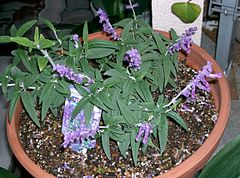Salvia leucantha
| Salvia leucantha subsp. var. | Mexican bush sage, Velvet sage | |||||||||||||||||||||||||||||||||||||||||||||||||||||||
|---|---|---|---|---|---|---|---|---|---|---|---|---|---|---|---|---|---|---|---|---|---|---|---|---|---|---|---|---|---|---|---|---|---|---|---|---|---|---|---|---|---|---|---|---|---|---|---|---|---|---|---|---|---|---|---|---|

|
|
| ||||||||||||||||||||||||||||||||||||||||||||||||||||||
| ||||||||||||||||||||||||||||||||||||||||||||||||||||||||
Salvia leucantha (Mexican bush sage) is a herbaceous perennial that is native to subtropical and tropical conifer forests in central and eastern Mexico. The flowers are usually white, emerging from coloured bracts. It is not frost hardy, but is often grown in warmer latitudes for its prominent arching velvety blue or purple inflorescences.[1]
It grows up to 1.3 m ft 1 high and 2 m ft 1 wide, with numerous erect stems, often arching at their tips, and with long inflorescences. The linear-lanceolate leaves are a soft mid-green, with whitish, hairy undersides.[1]
| Standard Cyclopedia of Horticulture |
|---|
|
Salvia leucantha, Cav. Shrub, about l 1/2-2 ft. high: st. shrubby, with elongated branches which are subterete, and white-lanate, the wool finally caducous: lvs. short-petioled, lanceolate-linear, acute, crenate, base rotundate, pubescent and rugose above, white-lanate beneath; floral lvs. ovate, acuminate, deciduous: raceme elongated, often purplish, 6-10 in. long; floral whorls many-fld., the lower remote; calyx subsessile, ovate, densely lavender- or violet-lanate; corolla white, white-lanate outside. June. Mex.—Probably not very common in cultivation, at least in N. Amer. CH
|
Cultivation
Propagation
Pests and diseases
Varieties
Gallery
References
- ↑ 1.0 1.1 Clebsch, Betsy; Carol D. Barner (2003). The New Book of Salvias. Timber Press. p. 171. ISBN 9780881925609. http://books.google.com/books?id=NM0iwB8GrQYC&pg=PA171.
External links
- w:Salvia leucantha. Some of the material on this page may be from Wikipedia, under the Creative Commons license.
- Salvia leucantha QR Code (Size 50, 100, 200, 500)

